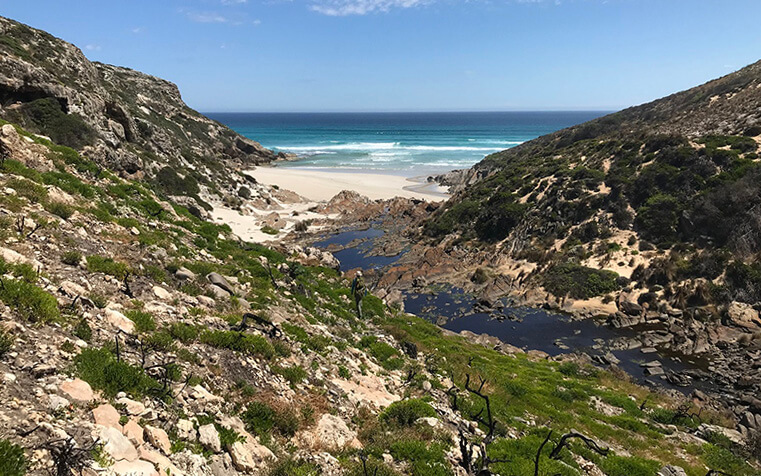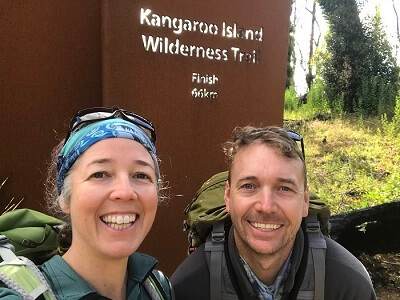
Author: Lisa Murphy
The Kangaroo Island Wilderness Trail (KIWT) is officially in recovery mode, as a Fire Recovery Experience. Reopened in December 2020, just 11 months after a devastating bushfire that burned the entire Flinders Chase National Park and one quarter of the island, we found ourselves quite by accident the first people to be “officially” walking on the trail since it reopened on 1st of December 2020.
We are also a Commercial Tour Operator (CTO) with National Parks South Australia and the only way you can currently book on to the Fire Recovery Experience is to book with a CTO. CTO’s perform risk assessments, familiarisation with trails to assist people with advice and guidance before taking groups or booking those wanting to go it alone. And certainly, since the fires we had much to revisit.
The trail itself had been completely destroyed – all four campgrounds were left with just the steel structures standing and while camping on the trail is not possible until the rebuild is complete – the trail now avoids these sites to allow for safe rebuilding to take place and this could take a year or two before they are reopened too.
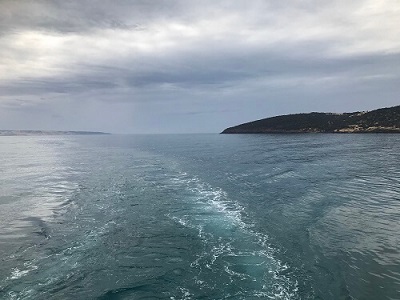
We arrived the day before we were due to start walking to explore other cool KI sites (Ki Spirits, and our fave café – Cactus Café) on the northern side of the island. Surprisingly, the ferry crossing involved calm seas (!) and it was spitting with rain as we drove through Penneshaw. The rain stayed for most of the day as we did what we needed to do in Kingscote and Parndana before driving to Western KI Caravan Park. We checked in to a cabin for the first night before moving to our tent the following night.
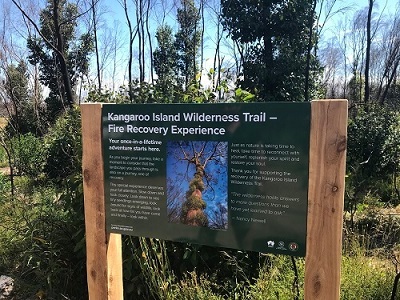
Day 1 Rocky River – 10km
After an induction with Alison from National Parks it was clear this was bigger than we realised – we were to be the first to walk the KIWT Fire Recovery Experience Trail officially. And the trail had issues still that we needed to be aware of – regrowth and rebuild had happened at the same time and the regrowth was faster than rebuild meaning the trail was hard to find in places. We needed to be focussed – wandering off the trail would mean difficulty to relocate the trail with no visual cues to guide us. It is not until you are there that you realise just how easy it is to wander off and how hard the trail is to find again. It can add time to your day of walking, especially where navigational skills are needed.
The trail had been modified in places and re-routed and we knew that there would be odd spots where markers were still missing. Having done the trail 3 times between the 2 of us in a 3-year period was definitely an advantage as we could at times use memory to find our way but this was also not always going to be helpful as it was a 66km trail in its original state! This was still less experience than those who work on the trail consistently who were even more familiar with the trail, so imagining what it might be like for someone who had never walked it prior to the fires was a point of view we had to consider as well.
Most importantly, how would it “feel” to walk the trail again as a KIWT Fire Recovery Experience? Would it be too emotional or sad for those wanting to experience it again? Would it be uplifting and inspiring?
Fiona from Western KI Caravan Park was our transfer driver and Caravan Park host alongside husband Mark. The rebuild in the park too has been slow, consistent and ongoing. Bit by bit their business is starting to grow again – they wait patiently for their home to be rebuilt and the caravan park office. The excitement of the very recent freezer delivery meaning that ice cream was now available was great news. Even better they stocked Ben and Jerrys and it was a warm day. Winning.
So off we drove into the very different Flinders Chase National Park. A portable hut and toilet is located in the original carpark where self drive visitors can sign in and buy Park Passes. We drove through a locked gate and stopped at the Rocky River trailhead. We were here. The trail was marked with one sign telling a brief on the Recovery Experience.
Well, the recovery was indeed evident. Gums with shoots covering burned trunks (looking like giant bonsai), gums shedding their scarred outer layers looking like a new tree. The cicadas were singing. It was almost Queenslandish – hot and humid for December. We found ourselves stopping – a lot. It was a lot to take in. An unformed path with diggings from goanna and soft sandy sections meandered around the bush. Grass trees appeared to have nesty tops, some had huge seed spikes towering on a mission to be the tallest and others had sprung up where they weren’t growing (or visible) pre-fire. The lichen was a bright red/orange against a backdrop of blackened tree trunks and blue skies. Dragon flies danced and the odd monarch butterfly joined the party. But man it was HOT. We stopped under a shady tree which was rare as so many had burned. Bending down, I spotted tiny fungi at the base. Exquisite. Flowers dotted the trail side. Everlasting daisies, the Christmas Bauble (totally my name for the plant and you will see why) and while we had missed orchid season, it was possible some might still be around, particularly the fire orchid.
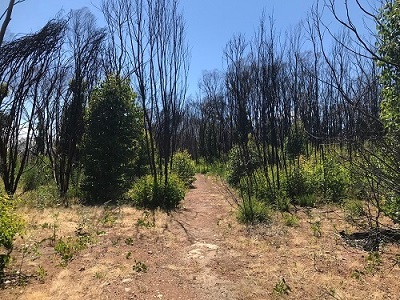
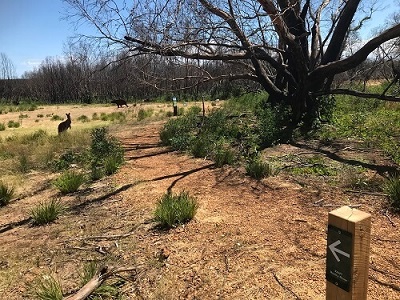
We crossed the bridge and road to where the trail followed the creek. Winding around grass trees on the original trail, we found ourselves heading up on a gradual incline. The hardest we had worked all day so far after so much flat. A gentle rise in the head felt like a bit of a slog (we don’t remember hills on this trail so we are quite sure we imagined it in a bit of heat induced deliruim). The sand colour changed to an orange shade and we knew we were close to Pardalote Lookout. Limestone started to appear under foot and disappeared after a while.
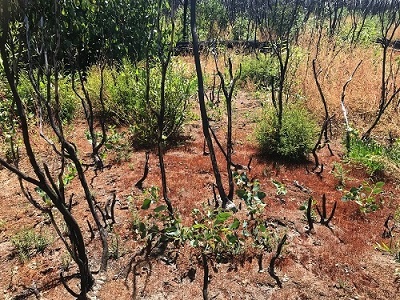
We could now see parts of the National Park that were previously hidden under dense scrub. The views at Pardalote showed the exposed Rocky River and bald hills of what looked like sand dune with dots of bush. There was no escaping the evidence of fire, lots of charred tree stumps, trunks and seed pods exposed and open after the fire. The regrowth was so intense in places it was difficult to believe fire had burned it all but it had. On the path new baby trees and shrubs decided it was a great spot to start new life and our job as walkers is actually to keep this regrowth from happening on the trail so that is stays recognisable for future walkers.
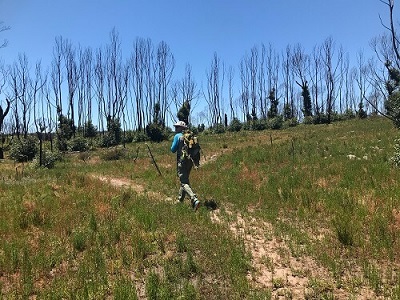
We probably heard 3 wallabies or roos thump away in shock at seeing/hearing humans but these were likely the only mammals on the trail that day. We saw a goanna on the drive home and birds such as parrots (rosellas) and what we thought might be a little wren or possibly a pardalote as it was a fast mover. The insect symphony of cicada buzz was deafening.
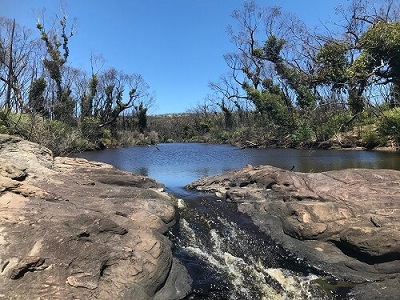
We walked in silence knowing that we were close to Cascades and the hope of seeing platypus was high (we were told they still live here even after the fire) but it was the wrong time of day. The sound of rushing water over the rocks and dragonflies hovering was welcoming as we sat here for 15 mins in silence eating lunch. We only had about 2km to go before reaching Rocky River and our finish point for today.
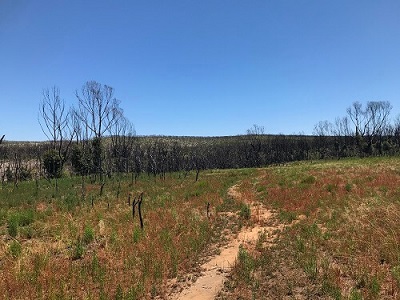
We followed the dry river trail by the water and with so little vegetation, you could see so much further than before the fires. The trail briefly inclined gently and we knew that this next section might not be as easy to find as it was yet to be pruned and marked. We stopped and backtracked several times over limestone that stubbornly refused to give us clues on what direction the trail went. Note this trail NEVER goes in a straight line (unless you are on a beach!) as it was originally designed to give you a “walk alone” experience. This has made for interesting navigation post fires….. A distant marker was spotted and the path become evident once more.
The turn off to the end of Rocky River section took us to Snake Lagoon, an open grassy area where a public campground used to be. We could turn off here but as we were ahead of time, someone decided that it would be great to visit the river mouth and beach. Given it was now 35 degrees and we were low on water after the unexpected heat it was a contentious decision.
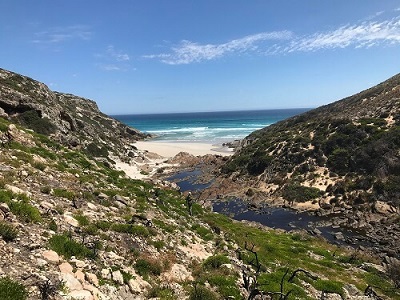
We headed down the hill to the river and followed it to the mouth. This section of trail is marked the Snake Lagoon Hike and is an extra 3-4km of walking if adding it to the first day. No-one really wants to backtrack that far (especially on a hot day) and we recommend doing this at the start of the second day of walking. We allowed an hour but it really took closer to an hour and a half with stops. We only spent a moment at the beach and realised we would be late for our pickup with the bus if we lingered. The beach here was so inviting but of course all the amazing looking ones have the worst currents and rips and while it was tempting to strip off and dive in, we had to just admire it instead. The incredible rock formations here, the baby waterfalls when the river is in flow plus a rocky scramble or too make this a fantastic adventurous section to add on. Definitely worth the side trip but add it to the start of Day 2 and it works out to be an additional 1.5km instead 😉
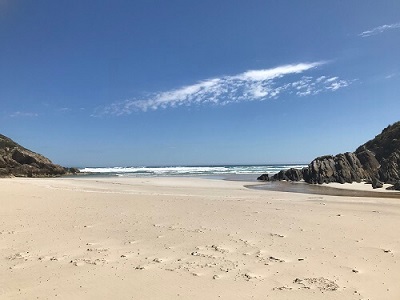
Seeing the bus waiting for us was a welcome sight – Fiona and Mark’s brand new Toyota Hiace was airconditioned and we recovered from mild heatstroke knowing that ice cream and ice cold drinks were waiting for us at the other end. We debriefed on our day with Fiona and reflected on the new section of Rocky River. She told us it reached 35 degrees today (it was supposed to be 27) and my almost delirium on that climb back up to Snake Lagoon felt validated. The cool change came in while we cooked dinner on the BBQ and relaxed on deck chairs. Not a bad way to end our first day on the trail.
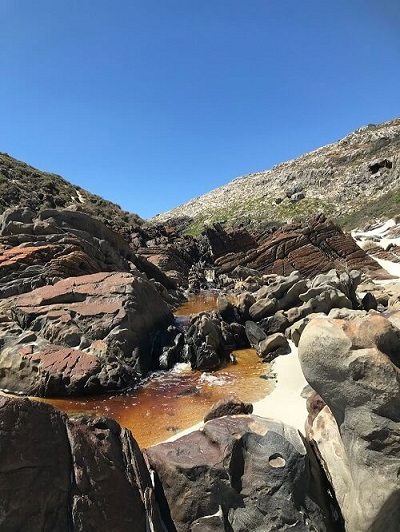
Day 2 Maupertuis – 16km
Heading back down to Rocky River on our second day was so much more comfortable in the cooler weather. What a contrast though! It was about 18 degrees and blowing a strong south easterly. We returned to the fire damaged landscape with fresh eyes after Fiona dropped us off at Snake Lagoon. We silently hoped again that platypus might be out and about in the early morning light. We crossed the boardwalk bridges across the river once more and followed the trail as it paralleled the river. We reached to the intersection where yesterday, we had headed down to the river mouth to that gorgeous beach. Such a great little side trip and worth the extra 1.3km return.
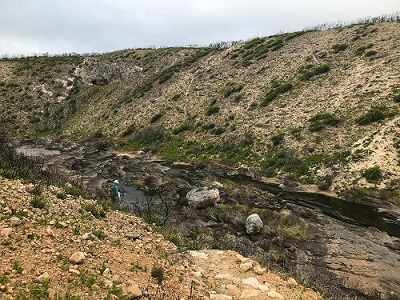
Today though we would head up the rise and over the headland to the most incredible views of not just Rocky River behind us with its terraced rock formations but also the mouth of the river itself and the divine coastline and beach below. Welcome to the mighty Southern Ocean!!!
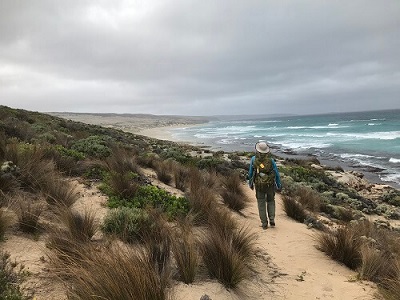
It’s an exposed walk from here with the wind and elements in your face. Just as well the scenery is spectacular with massive swell and surf below. Fire had reached all the way to the edge of the cliffs in most of this section too. But stopping to notice the small colourful patches of samphire and pigface growing once more was heartening. We knew the soft sandy beach of Maupertuis Bay was coming up – we remember this section well. The beach was so clean we only needed to pick up a few small items. The waves rolled in as we started slow, keeping an eye out for hooded plovers and pied oyster catchers.
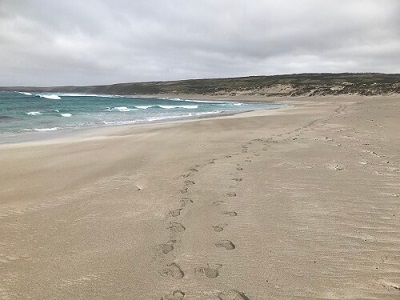
It was empty today except for just the one hooded plover spotted. Unexpectedly, the sand hardened a little as we reached the end of the beach and our pace quickened. That softy sandy section was honestly not as tough as we remembered (bonus!). We knew there was no shelter from this point onwards on this section so we decided to have morning tea under a small overhang that resembles a cave at the end of beach. A seal played in the shallows as we enjoyed a cuppa (thanks to the 2 cup thermos!) sheltered from the wind.
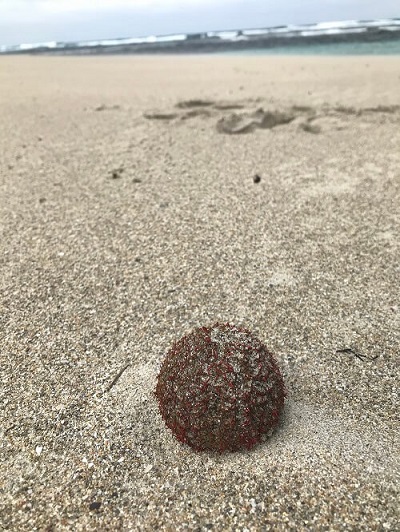
Coming up and off the beach the old boardwalk had mostly burned. Once we got a full view of the dune, a sadness washed over us. It was completely desolate and burned out. I remember almost exchanging pleasantries with a huge tiger snake the first time I had hiked this section 3 years ago and now there were no snakes or evidence of their tracks either. Sigh. The next few kilometres were really sobering. The coastal dune system seemed so much more fragile and vulnerable than our walk to Rocky River yesterday. Recovery we noted would take much longer here. There were some encouraging growth sections though and a couple of small untouched patches of plants and you could feel, see and hear the life of bugs and birds. The feeling of joy seeing this was hard to suppress. It felt like hope.
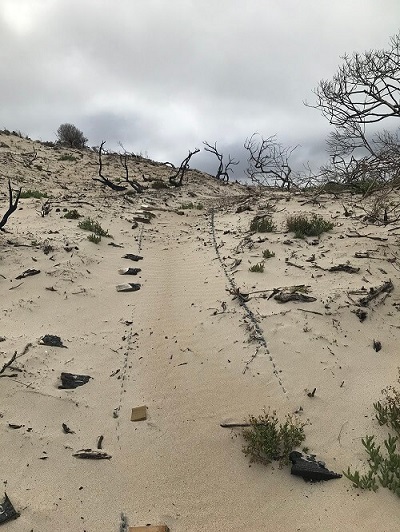
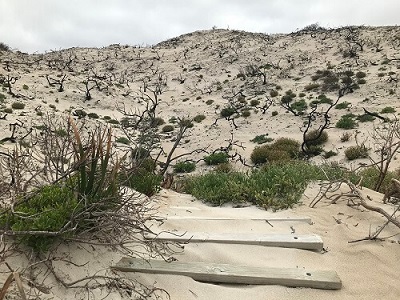
We definitely had issues finding the trail at times where it simply disappeared. We even had to back track a couple of times at the same spot. A sand dune is a moving being after all. The trail was swallowed up by wind and sand. Some of these sections would be difficult to navigate without damaging other fragile parts of this recovering ecosystem when venturing off in the belief of being on the trail and when not, trying to find the trail again – it was very challenging. We noted this as a potential ecosystem recovery issue for our report to National Parks.
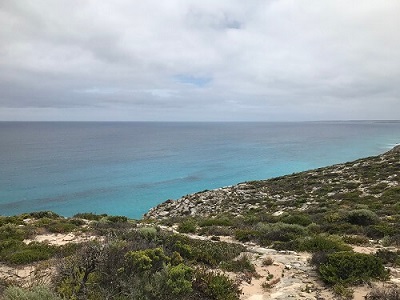
Once off the beach, the Cape de Couedic lighthouse appeared as a tiny icon in the distance. When you realise this is your finish point for the day, you can’t help but acknowledge how far away it is. The limestone rock (or moon rock as we call it) gives your feet a good work out. We took a break for lunch at a very exposed section near the cairn marking the shipwreck of the ill-fated Loch Sloy. This is a fascinating story and well worth a read from the KIWT Guide Book. The stretch of coastline here is littered with shipwrecks prior to the lighthouse being built. It would make for a great finish line.
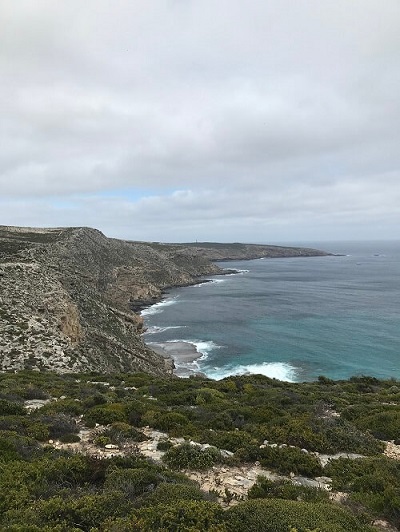
We allowed 6 hours plus the 1 hour river mouth side trip and it took us closer to 6.5 hours (without the side trip). Definitely felt emotions today as we left the beach and into the dunes. Navigating required us to concentrate for much of the day and with the final section on a track with pylons leading the way, knowing we couldn’t get lost, we zoned out for the final 1.2km into Cape to Couedic.
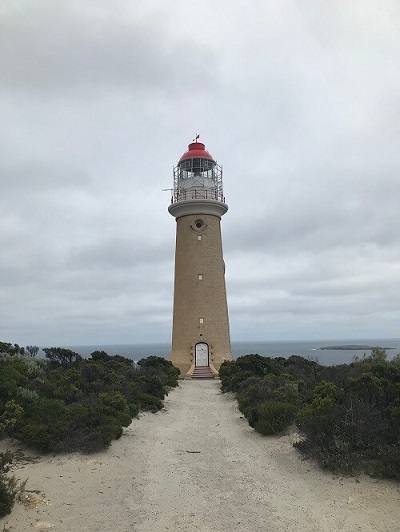
The next section is on road so we decided we would end our days walk at this roadside on future walks and headed down to Admirals Arch to meet the bus. Again Fiona was there waiting for us amongst the tourists who were now allowed to drive themselves into this part of the park. It was a big day and we felt knackered and windblown (plenty of sand grit!). Little did we know Day 3 would be the biggest challenge yet….
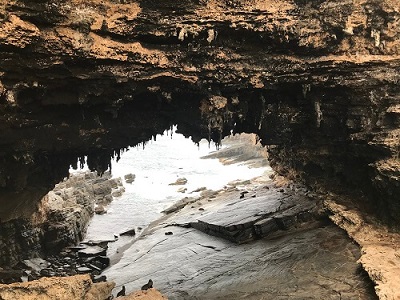
Day 3 Sanderson – 18km+/-
The third section is called Sanderson. This walk would start a little differently to what the maps would recommend. As we were a bit stuffed the day before we decided to head to Admirals Arch first thing before the crowds and spend a bit of time with the seals. It was another wild day on KI and chilly. We had the whole place to ourselves – just the seals and us and the smell. It really is one you won’t forget and depending on the wind direction, stays with you like an uninvited guest for sections of the walk out. We said goodbye to our furry friends and walked back up the stairs and up the hill to the lighthouse. There are also toilets here so a good spot to call in before heading to Weirs Cove.
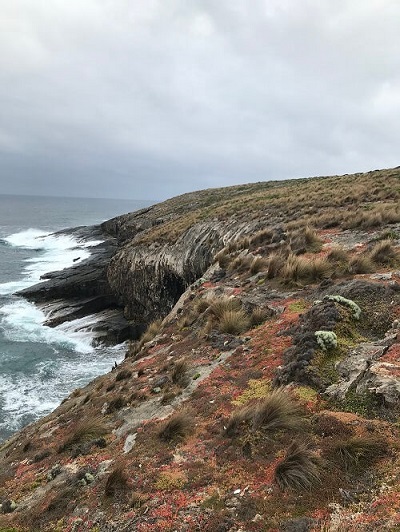
Weirs Cove is a fascinating site. To think not 1 but 3 families lived and worked the lighthouse on a rotational basis is phenomenal with supplies delivered only once every 3 months and were sent up the cliff on a pulley system that you can still look down on. Miraculously the fire somehow missed the cottages by the lighthouse (wind direction apparently) whereas everywhere else around the buildings was scorched – the one main building remained at Weirs Cove too. It was a bare dune walk with zero regrowth to this point. The views from here though are impressive.
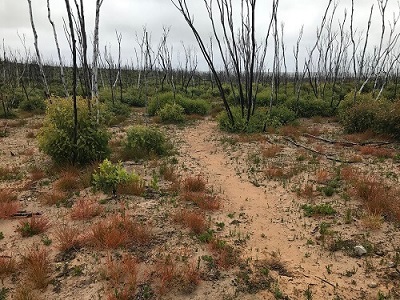
The trail then headed inland again for about 8km initially on sand before changing again to limestone moonrock. This used to be a dense section of mallee scrub that was high enough for you to never truly know where you were. You just walked it and zoned out. It twisted in directions that made you feel you were walking to Kingscote rather than Remarkable Rocks but now, it was all exposed. You could see the road, the pylons from yesterday’s walk and you realised just how far inland you came to head to Remarkable Rocks on the coastline again. The mind games this section offers though is another thing entirely. You question why you are going so far away from where you need to be and the trail itself is hard and I mean, really hard to follow. We noted this section as difficult to navigate in our report to National Parks.
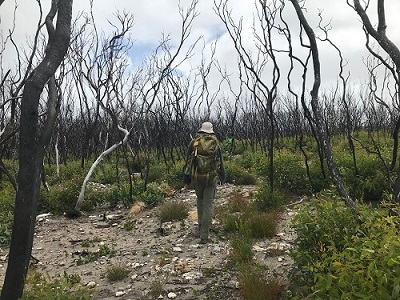
The regrowth is non-discriminatory so the trail will end suddenly and you wonder if you are still on it. You try to backtrack on what you think is trail but are you sure it really is the trail? Markers are hard to come across (usually every kilometre or half kilometre) but not in view. The trail winds and winds its way around and around. More than once we had to stop and try a few different directions before we were satisfied we were still on the trail. It took 1 hour to negotiate 1km. The limestone blended and trees had grown blocking the trail completely in parts. Occasionally some small pink tags on tree branches reassured us we were on the right track but without those I think we would still be out there. Where possible we laid tree branches to block the wrong way but it’s a big job to do this along this whole section of trail and so we tried our best to make it easier for the next group coming through. We used map and compass at one point to get our bearings near what looked like a huge goanna burrow. Again we noted this section as difficult to navigate in our report to National Parks.
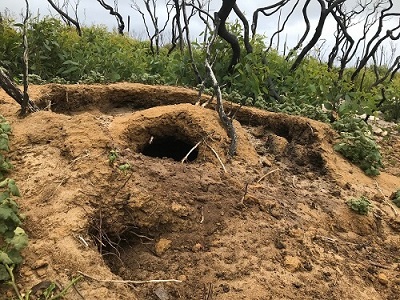
Dragonflies buzzed around us and the odd cicada sung along too – it was lovely to be out amongst it even though we did want to reach Remarkable Rocks some time that day. 6 hours after leaving Cape du Couedic we made it to Remarkable Rocks. We were pretty hungry and ready for a break. The Rocks were just as cool as we remembered them and while flames had licked right up to the edge, the brilliant orange lichen remained bright on the ocean side of the iconic landmark.
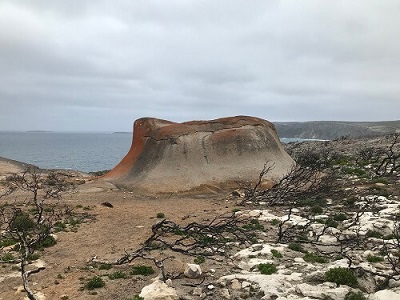
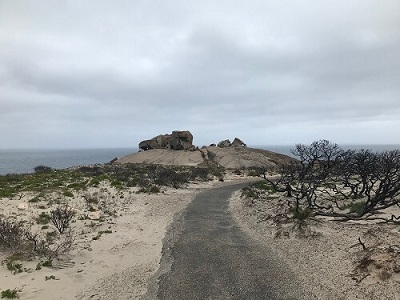
Some portable loos have been added to the carpark here and it was busy with day trippers. We had a chat to a ranger briefly before finding a rock to hide behind for lunch. We then headed onto the last part of the day with about 8km to go. We wondered if that might be a slow section too and so we decided to delay our bus pick up while we had phone coverage. Thankfully though the landscape was different to the morning and the trail was a tad clearer to follow.
We relaxed into the afternoon with a howling south easterly tainted by the smell of seals on the rocks below. The Rocks got smaller as we looked back along the coast with heaving seas and crashing waves. We really enjoyed this part with the views, the wind exposure and moon rock walking – it felt all a bit wild!
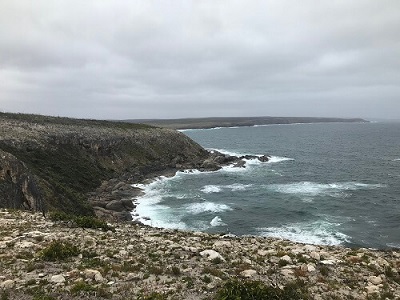
We could see Sanderson Beach further along the coastline knowing it was near our finish spot for today. Our pace was a huge improvement on the first part of our day and we relaxed into it. We knew that this was a section where echidna lived and we kept our eyes peeled as the diggings started to appear. The trail wound inland and into a basin that is lower than sea level and here, the shrubs and regrowth were the tallest we had seen so far. I remember this being a thickish section of woodland pre-fire. The fire though had exposed beautiful rocks that were dotted around a patch of grass trees. I imagined sitting on these with a group to collectively take a moment here in silence. I called them Reflection Rocks and it was a highlight to find them. It was also eerily still here after the gale winds and sea spray from half hour earlier. Stopping here meant we also saw a quadrupled grass tree that had 4 sections to it. They cope with fire and they dominate the recovery landscape. This one was particularly awesome.
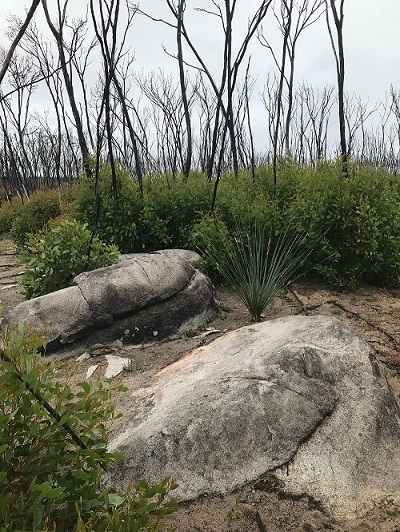
We were at the beach turn off just after Reflection Rocks for a quick sidetrip and with a bit of trial and error we followed the old trail. We made it to the beach with it’s angled shoreline cursed with strong rips and currents. Even paddling your feet here can be dangerous.

After returning from the beach, it was only a short walk to the road but here, we would see the old Banksia Campground remains in the distance. It was our fave campground and just parts of the steel structures remained from where we stood.
Today was a real mix of emotions – we reflected on understanding fire and how it misses bits but consumes and devours others, how it can burn all the way to cliff edges and how fragile the coastal systems are and how inland ecosystems recover faster. Not to mention the thriving grass trees.
We were absolutely done by the end of the walk. The bus arrived and we realised it was almost 5.30pm. We had headed off just after 8.30am that morning.
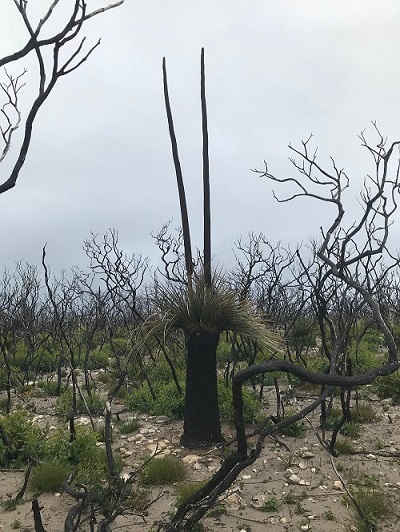
Day 4 Grassdale – 13km
The Grassdale section is the fourth section of the KIWT Fire Recovery Experience. We acknowledged before we even headed off today in the bus that we needed to leave the comparison chart at home and just walk. Of all the sections, this one had the most re-routing and yes it’s on fire tracks rather than walking trail but offers the chance to spot echidna and goanna and walk without the need to concentrate on navigation.
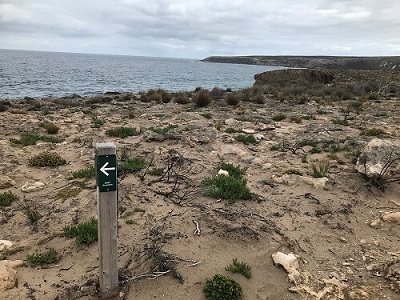
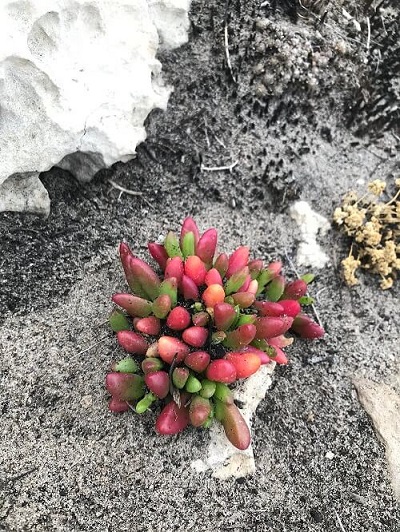
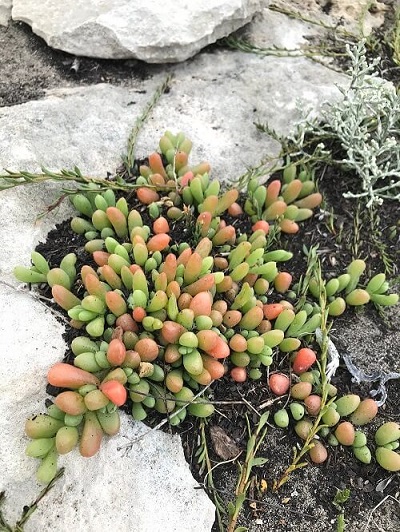
Initially though we stayed on the original track that follows the coastline along cliff top with Remarkable Rocks behind you and Cape Younghusband ahead. The seas seemed calmer today and the seals played on the flattish rocks below. There were only a couple of small sections not fire affected on Cape Younghusband and this was great to see. After the cape we followed the cliff for a short section and then the trail suddenly turned left and directed us to head inland on a nice wide and straight fire track. Diggings were everywhere here and we walked in silence in hope of spotting echidna or goanna. As we left the coastline the wind dropped, it was eerily quiet and peaceful. Just the flies for company.
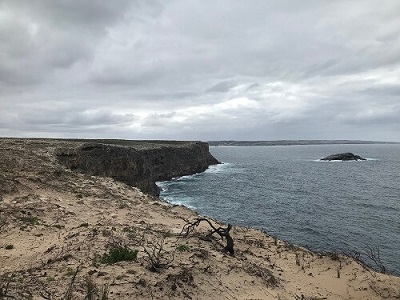
We had our morning tea stop sitting on limestone rocks shooing the flies as we poured from our little thermos. While the land here had burned, the acacia and grass trees were booming and offered green hope. Flowers dotted the edge of the trail and we spotted what we thought were goanna or echidna burrows. A few small birds could be heard but not seen (they flew too fast for us to positively identify them). It was great to see them returning.
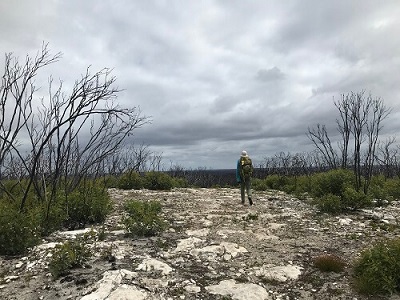
After about 4km the fire track reached an intersection with Sanctuary Track and we turned right onto this for a further 3.2km. We took our time and stopped to listen for animals – we did see butterflies and beetles plus the usual dragonflies too. Before we knew it though we had reached the end point for the Grassdale section at Hanson Bay Road. Just 13km in total. We were a bit early for the bus pick up and we decided lunch deserved an ocean view so we followed a pylon track for about 1.5km to the road and walked a small section of road for another 5 or so mins to get to the Bay itself. There are toilets here (that somehow miraculously survived) but almost the whole bay was burned – to the sand. In overcast skies we considered combining the next section into one day. The break from navigating along the fire tracks was a welcome break but also allowed some zone out time and a slightly faster pace than the trail walking. Despite moving so far away from the original trail we enjoyed the zone out time again.
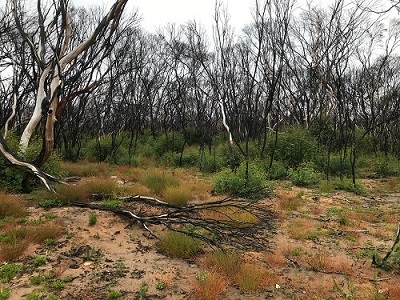
Our bus pick up was an early afternoon one (1.30pm) so we had the afternoon to relax after some bigger days of walking. The Caravan Park campsite was the perfect place to chill out and relax – and even people watch. The koalas had been active at night here and also during the day. The Cape Barron geese also flew in for a visit. The kangaroos and wallabies were also keen to see what was on the menu for dinner at dusk. After not seeing much on the trail it was so good to see wildlife hanging out with us.
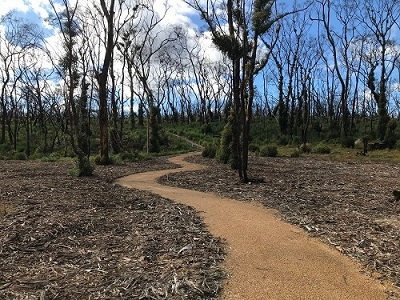
Day 5 Kelly Hill – 10km
The final section we completed was Kelly Hill. The weather was stunning with blue skies, sunshine and puffy white cloud. After so many overcast days, the blue skies were welcome! Traditionally we would have started at Grassdale and walked to Kelly Hill Cave in the past but to end on something a little more uplifting than a site of devastation it was decided it was better to end on beach (with wet feet in case the river was flowing still and not yet sealed over for the summer).
Starting at Kelly Hill Cave was not an easy start to the day. My last memories here were spotting echidna while our tour group went underground on a ranger guided cave tour. Blue wrens were dancing near the shelter and it was so beautiful to sit amongst the gums. I took a huge breath in as I surveyed the carpark knowing the infrastructure and loss of beautiful bush and wildlife weighed heavy. We could see the old “finish line” sign and we headed there to start our 10km walk to Hanson Bay.
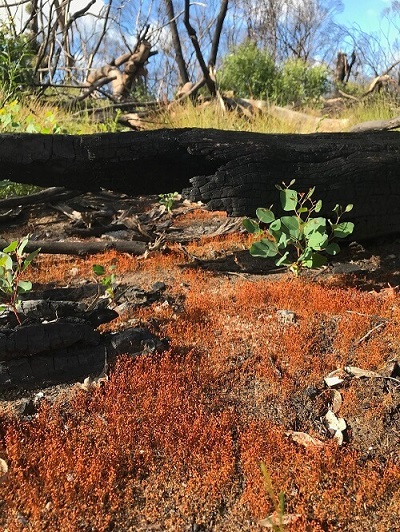
The bush was fairly thick with regrowth as we wound our way through the Conservation Park. We passed caves and huge gums that showed shoots of green covering charred trunks. Again the pace of faster regrowth here was evident within this ecosystem. It was sandy under foot and open with grass trees, banksias and lots of little flowers to admire. We heard there may still be orchids in a section before we reached the lakes but we could not find them despite spending a good 20 minutes searching them out. There were oodles of dragonflies including the blue ones, cicadas and more bees than anywhere we had seen on the trail so far.
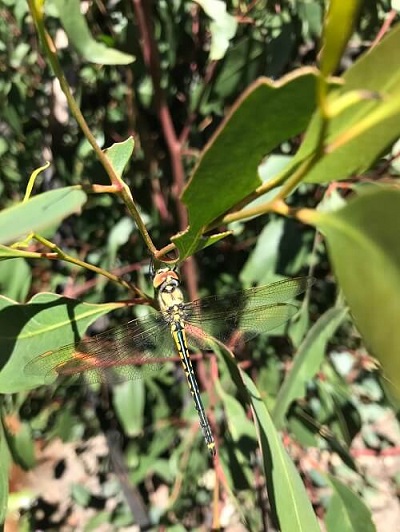
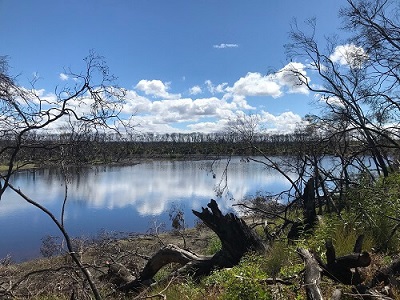
We climbed the little hills we forgot were part of this mostly flat trail around the lagoon and lake which now had better views than before the fire. The water was still and reflected the blue sky with puff cloud for reflection perfection – just beautiful. We also saw a family of swans, cormorants, ducks and a grey heron. At times the trail was difficult to pick out and we were grateful for ribbons in the trees. We climbed a few fallen logs and noted that this was going to be a busy section of rebirth.
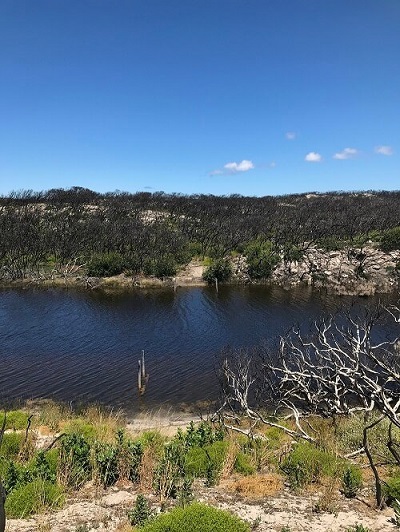
Passing the old grassy area known as Grassdale, it was empty of kangaroos, but they will return here over time. We soon reached the river where the little punt boat used to be the only way of crossing. So much fun operating this using the pulley system – nothing remained except the steel structures in the water that used to hold the wooden platforms. A very unique feature to the trail that we are told will return (yay). The river is brackish here but has fish (mullet we were told) and we also thought what a great place to go kayaking on these calm inland waters.
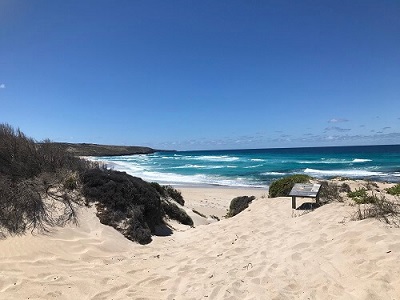
The dunes at Hanson Bay were our final little climb up onto a gorgeous vantage point with views of turquoise waters on a sunny day. The white sandy beach offered an opportunity to take boots off and earth ourselves before finishing across the bay where the road meets for pick up.
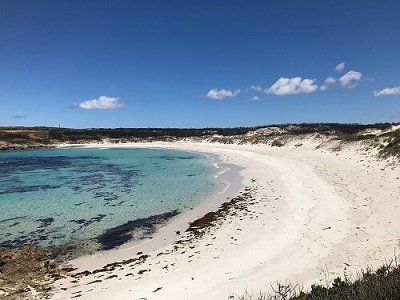
Today’s walk was short, we were done in well under 4 hours and we felt that the two sections of Grassdale and Kelly Hill could be combined when we return next year with our groups. We also reflected on how long recovery takes after fire. All fires are different and the pace of recovery changes in each landscape. You could walk this trail multiple times a year and see significant or no change depending on the section. So we know that what might look desolate and devoid of fauna and flora now, will not stay like this for long. First the insects return to the plants and trees, then the birds, reptiles and the animals. From here on, the KIWT Fire Recovery Experience will get better and better!
Following our KIWT Fire Recovery Experience, we provided a detailed report to National Parks based on our observations. This report will be used to help improve those sections of trail that are undefined and difficult to navigate.
So how do we feel after completing the KIWT Fire Recovery Experience?
- Uplifted: Seeing so much regrowth and the start of the return of insects, birds and wildlife
- Privileged: To have the opportunity to witness the trail revived from the ashes
- Grateful: Wow, to be walking here again fearing the trail would not reopen is amazing
- Aware: We feel just a little more educated on fire recovery than we did before
- Hopeful: This is just the beginning of the recovery phase
Should you book on the KIWT Fire Recovery Experience?
- Yes! But we don’t suggest self guided walking until the trail is better defined, unless you are an experienced navigator – this is to reduce the number of walkers becoming lost and also to protect the ecosystem off trail that is trying to re-establish. The KIWT Fire Recovery Experience is an amazing opportunity to see nature return after intense bushfire.
How can you walk the KIWT Fire Recovery Experience Trail?
- As at December 2020, the only way to book the KIWT Fire Recovery Experience is with a pre-registered Commercial Tour Operator (CTO)
- The closest accommodation to the trail (while the campgrounds are closed and being rebuilt) is Western KI Caravan Park.
I don’t have navigation skills or confidence – can I still do the KIWT Fire Recovery Experience?
- Yes you can still walk the trail but we recommend for your own safety that you join a small-group guided tour so that you don’t have to worry about navigating, walking off trail or getting lost. We have KIWT Fire Recovery Experience(s) departing from March to October.
Check out a VLOG of this adventure on our Youtube Channel.
Additional Reading
Big Heart Adventures is a commercial tour operator (CTO). Registered to lead walking adventures along the KIWT Fire Recovery Experience Trail on Kangaroo Island and throughout Australia and overseas. We offer fully guided walking tours and self guided walking adventures.
You can see our Kangaroo Island walks here
Read more about ‘Big Heart Adventures’ and our wellness walks
Get information on our women’s walking group ‘Wise Women Walking’
We look forward to sharing a Big Heart Adventures South Australian Walking Experience with you!
For more general information on the KIWT Fire Recovery Experience head to National Parks and Wildlife Service SA
We would like to thank National Parks, in particular Alison Buck for her assistance with getting the trail back up and open again. We would also like to thank Fiona and Mark for their hospitality at Western KI Caravan Park.

